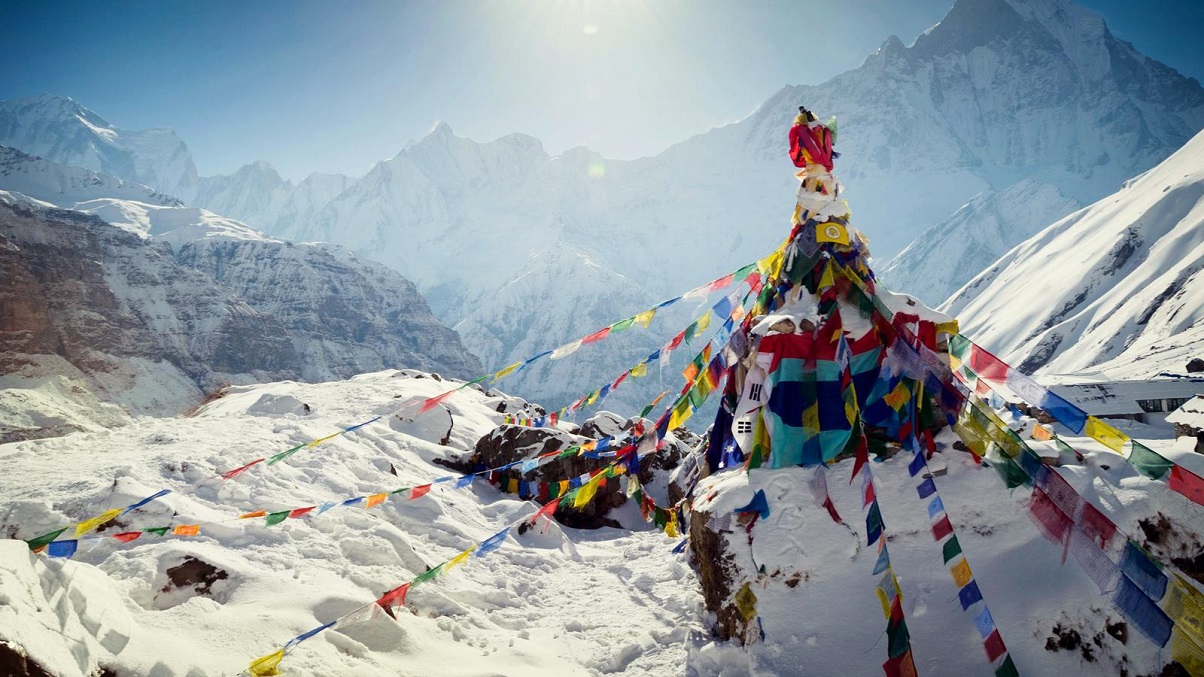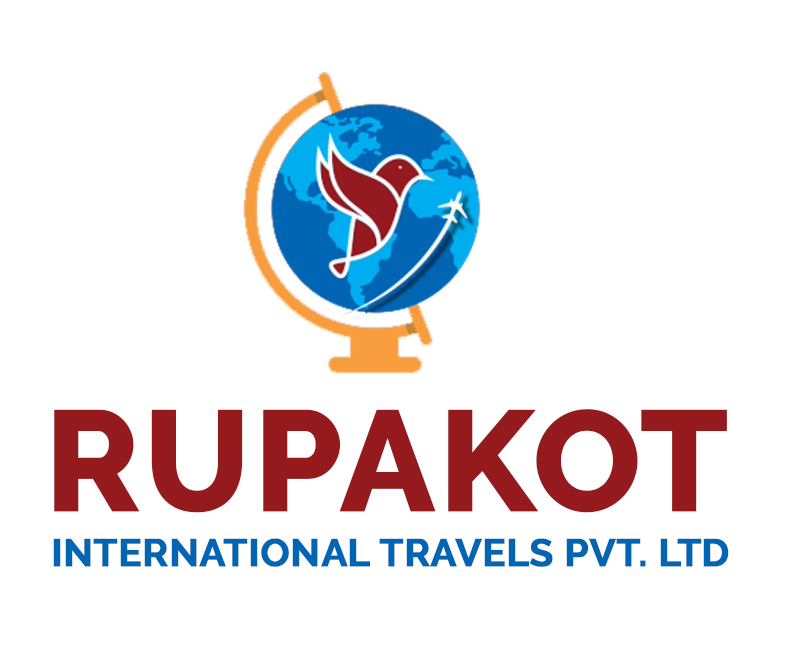
Become friends with Rupakotholidays to be the first one to know about exclusive deals and discounts.

Our extraordinary journey begins with a bold adventure, starting in the tranquil mid-hills and gradually ascending toward the majestic foothills that embrace the tallest peak on Earth.
This unforgettable expedition follows the renowned route to Everest Base Camp via Jiri, offering breathtaking views and exceptional experiences. Nestled in the heart of Nepal, the Everest region draws adventurers from across the globe with its stunning landscapes and rich cultural heritage.
Everest Base Camp is more than just a destination—it’s an exploration of nature’s grandeur and human perseverance. As we trek through the Khumbu Region, each step reveals the vibrant Sherpa culture and the mystique of the Himalayas.
At Rupakot Holidays, we invite passionate explorers to take on the challenge of trekking in Nepal. Our journey offers an unparalleled chance to connect with the rugged beauty of the Himalayas. This is not just a trek; it’s a transformative odyssey where each ascent fills you with renewed strength, and every panoramic view inspires awe.
Join us on this incredible adventure, where the summit of Mount Everest represents both the heights of human determination and the endless possibilities of exploration. In a land where adventure knows no limits, we embark together on a journey where every moment is shaped by the indomitable spirit of discovery.
Day 01: Arrival in Kathmandu (1,300m)
Upon your arrival at Kathmandu’s Tribhuvan International Airport, you will be welcomed by representatives from Rupakot Holidays who will transfer you to your hotel. After settling in, one of our leaders or a senior Sherpa guide will provide an orientation session about the hotel, Kathmandu, the trek, and useful tips for your stay in Nepal. This is your first night in the land of the gods, complete with breakfast
Day 02: A Day in Kathmandu
After a restful night, you'll receive information about your half-day guided sightseeing tour in Kathmandu, taking in some of the city's most iconic attractions. Depending on your flight arrival time, if you arrive late, this tour may take place in the afternoon, allowing you some rest to recover from jet lag. Enjoy an overnight stay at your hotel with breakfast.
Day 03: Drive to Jiri (Approx. 1,900m) – 6-7 Hours by Bus
After breakfast, we depart for Jiri by deluxe coach. The scenic drive winds through the foothills of the Himalayas, passing through Lamosangu—a small bazaar near the Tibetan border—before continuing towards Charikot. From there, we descend into the Tama Kosi River and then climb again, finally arriving at Jiri, a once-bustling town. Upon arrival, we set up camp near the village and take time to mingle with the locals. All meals will be provided at camp.
Day 04: Trek to Shivalaya (1,770m) – 5 Hours
Our first trek takes us from the bazaar of Jiri, climbing steadily for about an hour until we reach a ridge offering a view of the village below. After passing through small farm villages and terraced farms, we climb to Kharubas pass (2,712m), where Buddhist prayer flags and a chorten mark the spot. After a break, we descend to Shivalaya, where we camp next to the river. Time permitting, you can explore the surrounding village. All meals are included.
Day 05: Trek to Bhandar (Chyangma) (2,195m) – 5 Hours
After breakfast, we begin with a steep climb to the village of Sangbadanda. The route then follows a gradual path through forests and villages before reaching Deurali pass (2,715m), where we pause to enjoy a break. From Deurali, we can see Bhandar below. The final stretch takes us downhill for about two hours to our camp at Bhandar, where we’ll encounter a mixture of Sherpa and Newar communities. All meals are provided at camp.
Day 06: Trek to Sete (2,575m) – 6-7 Hours
Today's trek begins with a descent through forests and terraces until we reach Phedi, a village where the climate begins to change. From there, we continue to Likhu River and cross a long suspension bridge. After passing the small village of Kenja, we head north-east, passing through pine forests and villages until we arrive at Sete. Here, the air is cooler, and we set up camp near the village monastery or in the yard of a nearby lodge. All meals are included.
Day 07: Trek to Junbesi (2,675m) via Lamjura-la (3,530m) – 6-7 Hours
Today, we start with a steep climb through a rhododendron forest, eventually reaching Lamjura-la, the highest point of the trek so far. After taking in the views, we descend through a forest of fir and rhododendron towards the Sherpa village of Thakdor, where we pause to admire a large carved Mani rock. From there, we descend further, reaching Junbesi, a large Sherpa village known for its chorten, monastery, and the school built by Sir Edmund Hillary. We set up camp near Junbesi Khola or in the village, depending on available space. All meals are included.
Day 08: Rest Day in Junbesi
Today is a rest day. You can choose to explore the village, visit the serene monastery, or relax with some reading. For those interested in Tibetan Buddhism, an optional hike leads to the Thubten-cho-ling monastery, the most important monastery in the Solu Khumbu district, established after the Chinese occupation of Tibet. The monastery is home to over 100 monks. Overnight at camp with all meals provided.
Day 09: Trek to Nunthala (Manidingma) (2,190m) – 6-7 Hours
Today's journey begins with a short descent to the river, followed by a climb around Shingsere Danda. As we continue, we pass through forests and small villages, eventually getting our first view of Mount Everest. We descend to the Beni Khola valley and cross the river before continuing uphill towards the village of Ringmo. From here, we make our way to Trakshindu pass (3,070m), marked with prayer flags. The path descends to Nunthala, a village known for its Sherpa and Rai inhabitants. We set up camp here for the night, interacting with the locals. All meals are included.
Day 10: Trek to Bupsa Danda (2,250m) – 5-6 Hours
Our morning trek begins with a steep descent to the Dudh Koshi River, followed by a gradual uphill climb to the village of Jubing (1,675m). From here, we continue towards Kharikhola (2,200m), a village known for its mani walls and water wheels. After a break, we climb steeply to the settlement of Bupsa, where we’ll camp near the farm fields with spectacular views of the surrounding hills and valleys. All meals are included.
Day 11: Trek to Surkhe (2,295m) – Approx. 5-6 hrs
As we move closer to the Khumbu area, the air becomes cooler. The trail begins with a climb through a meandering path surrounded by oak, rhododendron, and fragments of the Nepalese paper plant, Dhaphne bholua. The area is rich in birdlife, including pheasants.
Our route continues along the Kharte Dande ridge, which offers a stunning view above the river. We reach the Kharte La at 3,880m, before descending to Puiyan village (2,800m) for a lunch break. This peaceful spot, nestled in the forest, offers a great resting place. After lunch, the path remains gentle as we walk for a couple of hours, slowly ascending the Sebuk Danda to Chotok La at 2,945m. From here, we can enjoy views of Lukla’s airstrip and Surkhe village.
The descent of nearly 700 meters brings us to Surkhe, where we camp near a stream. Surkhe, located just below Lukla’s hills, offers a unique view of airplanes flying overhead during sunny winter days. All meals are included.
Day 12: Trek to Phakding (2,650m) – Approx. 5-6 hrs
From Surkhe, we head westward to join the main Lukla trail. If time allows, you can visit Lukla, which is a 2-hour steep climb. The walk continues to Muse and Ghaikharka villages. After two hours of steady walking, we reach Choplung, where the Lukla trail merges.
The rest of the day is a pleasant journey with few uphill stretches. After crossing the suspension bridge at Tarhe Khola, we get beautiful views of Kusum Kangru (6,369m). A short climb leads us to Ghat village, followed by a final stretch to Phakding village, located along the Dudh-Kosi river. Overnight at Phakding with all meals included.
Day 13: Trek to Namche Bazaar (3,440m) – Approx. 5-6 hrs
The day begins by crossing the Dudh-Kosi suspension bridge, followed by a steady ascent that fluctuates in elevation. Views of Thamsarkhu (6,608m) are visible from Benkar village. After crossing another suspension bridge over the Bhote-Koshi river, we reach Monjo, where we explore traditional water-mills grinding corn and barley.
We continue to the entrance of Sagarmatha National Park, where our trekking permits and park tickets are checked. After a short descent, we cross another suspension bridge at Jorsalle village, the last village before Namche Bazaar.
The final stretch brings us to Namche Bazaar after a 1-2 hour climb. From Thop Danda, we get spectacular views of Kwangde peak, Kusum Kangru, Mt. Everest, Nuptse, Lhotse, and Taweche peak. Namche Bazaar, with its colorful houses, resembles an amphitheater. Overnight in Namche with all meals included.
Day 14: Rest Day in Namche Bazaar
Today is for rest and exploration. A visit to the Sagarmatha National Park Headquarters offers breathtaking views of the surrounding peaks and valleys, and the museum provides fascinating insights into the region’s geography, culture, and mountaineering history. You’re free in the afternoon to explore Namche Bazaar. Overnight in Namche with all meals included
Day 15: Trek to Thyangboche (3,867m) – Approx. 5 hrs
The trail starts easy, leading us from Namche Bazaar along a gradual path. After about two hours, we reach Shanasa, a great spot for birdwatching. Here, you might spot the colorful Danphe pheasant and even musk deer.
The path continues to descend to Phungitenga (3,250m) before a challenging 1-hour climb through forests. Eventually, we reach the Buddhist entrance gate to Thyangboche, with its stunning monastery and views of Ama Dablam, Everest, Nuptse, and Lhotse. Overnight in Thyangboche with all meals included.
Day 16: Trek to Dingboche (4,358m) – Approx. 5-6 hrs
The journey from Thyangboche takes us downhill to Deboche (3,650m), with incredible views of Ama Dablam, Everest, Nuptse, and Lhotse. We continue past the long mani prayer wall and cross a bridge over the Imja-Tse river.
The trail then climbs gradually towards Dingboche, passing the upper Pangboche village and its monastery. After exploring the monastery, we head to Shomare for lunch, offering fantastic views of Ama Dablam. Our journey continues to Dingboche, a beautiful village surrounded by stone walls, offering stunning views of the surrounding peaks. Overnight in Dingboche with all meals included
Day 17: Trek to Loboche (4,928m) via Dugla (4,595m) – Approx. 5 hrs
From Dingboche, we begin with a gradual climb, offering views of Mt. Tawache, Ama Dablam, and Pokalde peak (5,741m). After a couple of hours, the trail joins Pheriche before ascending steeply to Dugla, where memorials honor climbers who have perished in the region.
After a short break, the path continues to Loboche. This small village, hidden from the wind, offers stunning views of Pumori and other nearby peaks. Overnight in Loboche with all meals included.
Day 18: Trek to Gorakshep (5,288m) & Kalapathar (5,545m)
Today’s journey takes us to Gorakshep, passing rocky moraines and offering views of Khumbu Glacier. Once at Gorakshep, we continue towards Kalapathar, a challenging 45-minute climb.
From Kalapathar, the panoramic views of Everest, Nuptse, Lhotse, and other surrounding peaks are awe-inspiring. The sight of Everest from here is unforgettable, and it’s truly a moment to cherish. We return to Gorakshep for the night. All meals included.
Day 19: Trek to Everest Base Camp (5,357m) – Approx. 5-6 hrs
Today, we head to Everest Base Camp, following a challenging path through rocky dunes, moraines, and streams. The walk is strenuous due to the altitude, but the views of Khumbu Icefall make it worthwhile.
After reaching Everest Base Camp, we retrace our steps back to Loboche for the night. All meals included.
Day 20: Trek to Pangboche (3,900m) – Approx. 5 hrs
From Loboche, we descend via Thugla and Pheriche before continuing downhill to Pangboche. After a scenic walk, we set up camp in Pangboche for the night, with all meals included.
Day 21: Trek to Khumjung (3,800m) – Approx. 6 hrs
Today, we retrace our route to Shanasa and then take a scenic detour to Khumjung. This village is quieter than Namche and is home to a monastery housing a yeti's scalp. We’ll camp in Khumjung with all meals included.
Day 22: Trek to Monjo – Approx. 4-5 hrs
We walk downhill from Khumjung, visiting the Khunde Hospital before continuing to Syangboche and descending to the Dudh Koshi river. After passing Namche Bazaar, we reach Monjo for the night. All meals included.
Day 23: Trek to Lukla – Approx. 5 hrs
Our final day on the trail brings us to Lukla. The walk is pleasant, with a final climb before reaching the town. Once in Lukla, we celebrate with a traditional dinner and enjoy a final party with our Sherpa crew and fellow trekkers. Overnight in Lukla with all meals included.
Day 24: Flight from Lukla to Kathmandu
After breakfast, we board a flight from Lukla to Kathmandu. The scenic flight offers a last view of the Himalayas. Upon arrival in Kathmandu, our staff will escort us back to the hotel. Breakfast included.
Day 25: Free Day in Kathmandu
This day is free for you to explore Kathmandu. You can take part in a short tour or enjoy a scenic mountain flight. Overnight in Kathmandu with breakfast included.
Day 26: Transfer to the Airport
As per your international flight time, we’ll escort you to the airport for your departure. It’s been a wonderful journey, and we hope you’ve enjoyed your time in Nepal. Breakfast included.
Trip Information
A ‘TH [Teahouse Lodge]’ refers to staying in teahouse lodges along the trekking trails. These teahouses offer basic accommodations, providing a warm and cozy environment to unwind after a day of hiking. While you’ll typically have a single room when available, sometimes you may have to sleep in dormitory-style rooms for the night. Rooms usually consist of a bed with pillows and blankets. If you'd like a little more comfort, feel free to bring your own ‘air pillow’ for added convenience. The whole experience embraces the adventure of the wild, and the rougher it gets, the more rewarding it feels. Our trek groups are accommodated in local lodges each night. Our porters hike ahead to secure the necessary rooms (since rooms cannot be booked in advance). Keep in mind, some lodges are quite basic, so a sense of adventure is key. Staying in lodges is also more affordable compared to organizing a camping trek.
For accommodations in Kathmandu, we offer a variety of 3-4-5 star hotels for our clients, unless otherwise specified or if clients have specific preferences. You can find more information about these hotels on our website. Rest assured, finding suitable accommodations is never an issue, and the choice is entirely yours.
Dining
At ‘Rupakot Holidays,’ we maintain a strict policy of never compromising on the quality of food provided to our trekking guests. We understand how challenging trekking can be, so we ensure that all lodges provide three hearty and nutritious meals each day, with a variety of local and Western options.
Breakfast is a fulfilling start to the day, offering choices like porridge, muesli, cereals, omelets, scrambled or fried eggs, along with chapattis or bread. For lunch, you'll enjoy a variety of salads, cooked vegetables, pasta, and traditional breads.
After a long, demanding day on the trail, dinner is a comforting 3-course meal, beginning with soup and followed by a mix of vegetables, meats, rice, and pasta dishes. A simple yet delicious dessert might also be served. You may even be treated to a delightful ‘apple pie’ that is sure to surpass any you’ve had in Thamel! Tea, coffee, and hot chocolate are served at all meals. We prioritize fresh, local ingredients and can accommodate special dietary requests. Our local trek leaders are vigilant in maintaining high health and hygiene standards in the kitchens, ensuring the cleanliness of food preparation and personal hygiene within the group. This attention to detail has allowed us to maintain excellent health standards for many years of successful trekking.
We only serve well-cooked meals, and vegetables are treated with potassium permanganate or iodine for safety. Boiled water is provided for drinking, and we supply antiseptic soaps and treated water for washing. Special dietary needs can always be met, and while “gluttony is a sin,” we leave it up to our guests to determine their appetites—there are no restrictions when it comes to enjoying the food! Bon Appétit!
The ideal times to embark on a trip like this are during Spring and Autumn. These seasons offer breathtaking landscapes, with clear skies and sunny weather that highlight the natural beauty of the surroundings. The scenery during this time is truly remarkable and distinct. We can tailor our program to fit the preferences and choices of your group, ensuring that your holiday is a unique and unforgettable adventure that you'll cherish for a lifetime.
Cost Inclusions:
Cost Exclusions:
Trip Duration:26
Trek Type:21 Days out in the wild
Total Trip:25 Night 26 Days.
Grade:Moderate – Adventurous
Highest Altitude:5,545 meters at Kalapathar.
Arrival City:Kathmandu
Departure City:Kathmandu
Transportation:A tourist coach & a flight
© 2026 Rupakot Holidays (P) Ltd. All rights reserved.
Powered by: Nectar Digit
© 2026 Rupakot Holidays (P) Ltd. All rights reserved.
